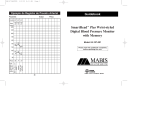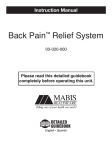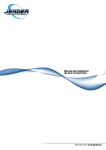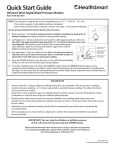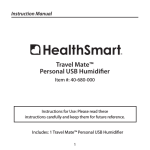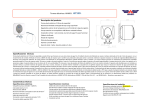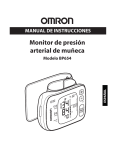Download 04-237 Instructions
Transcript
Instruction Manual Sports Wrist Digital Blood Pressure Monitor Item # 04-885-001 Please read this guidebook completely before operating this unit. English • Spanish Limited Five-Year Warranty Index The warrantor guarantees that its Digital Blood Pressure Monitor will be free from manufacturing defects under normal use for five years from the original purchase date. This warranty covers only normal use, and does not apply to use in any clinical or commercial applications. This warranty does not cover batteries or other power sources that may be provided with or used with the Digital Blood Pressure Monitor. This warranty is voided if the Digital Blood Pressure Monitor product is misused or abused in any manner. Introduction . . . . . . . . . . . . . . . . . . . . . . . . . . . . . . . . . . . . . . . . . . . . . . . . . . . . . . . . . . . . . . . 2 If the Digital Blood Pressure Monitor fails to operate during the first five years from the time originally purchased, please call our Customer Care Help Line at 800-622-4714 and we will try to resolve the issue as soon as possible. If the warrantor determines the unit failed to operate due to a manufacturing defect, the unit will be replaced at the option of the warrantor. Replacement is the sole remedy under this limited warranty. This warranty gives you specific legal rights, which vary from state to state. As a condition of this warranty, the enclosed warranty registration card must be completed and sent to us within 10 days of the purchase date or can be filled out online at www.mabisdmi.com. This warranty constitutes the warrantor’s only responsibility and obligation to replace materials or components. We make no other express or implied warranties, arising by operation of law or otherwise, or any warranty of merchantability or fitness for a particular use or purpose whether or not the use or purpose has been disclosed to the warrantor in specifications, drawings or otherwise, and whether or not the warrantor’s products are specifically designed and/or manufactured by the warrantor for the buyer’s use or purposes, except for the limited warranty stated above. The warrantor will not be responsible for any indirect, incidental, special, consequential, or punitive damages or other loss, including, but not limited to, damage to or loss of other property or equipment and personal injuries, whether to purchaser or others. The warrantor shall in no event be liable to the purchaser for any amount in excess of the cost of repair and/or replacement of the unit. Product Identification and Caution . . . . . . . . . . . . . . . . . . . . . . . . . . . . . . . . . . . . . . . . . 3 General Blood Pressure Information . . . . . . . . . . . . . . . . . . . . . . . . . . . . . . . . . . . . . . 4-6 Important Information Before Use . . . . . . . . . . . . . . . . . . . . . . . . . . . . . . . . . . . . . . . . . 7 World Health Organization (WHO) Indicator . . . . . . . . . . . . . . . . . . . . . . . . . . . . . . . . 8 Irregular Heartbeat Detection . . . . . . . . . . . . . . . . . . . . . . . . . . . . . . . . . . . . . . . . . . . . . . 9 Battery Installation/Replacement . . . . . . . . . . . . . . . . . . . . . . . . . . . . . . . . . . . . . . . . . 10 Setting the Date/Time . . . . . . . . . . . . . . . . . . . . . . . . . . . . . . . . . . . . . . . . . . . . . . . . . . . . .11 Applying Your Blood Pressure Cuff . . . . . . . . . . . . . . . . . . . . . . . . . . . . . . . . . . . . . 12-13 Taking Your Blood Pressure Reading . . . . . . . . . . . . . . . . . . . . . . . . . . . . . . . . . . . 14-15 Recalling Measurements in Memory . . . . . . . . . . . . . . . . . . . . . . . . . . . . . . . . . . . . . . 16 Description of Display Symbols . . . . . . . . . . . . . . . . . . . . . . . . . . . . . . . . . . . . . . . . 17-18 Troubleshooting . . . . . . . . . . . . . . . . . . . . . . . . . . . . . . . . . . . . . . . . . . . . . . . . . . . . . . . . . . 19 Care and Maintenance . . . . . . . . . . . . . . . . . . . . . . . . . . . . . . . . . . . . . . . . . . . . . . . . . . . . 19 Product Specifications . . . . . . . . . . . . . . . . . . . . . . . . . . . . . . . . . . . . . . . . . . . . . . . . . . . . 20 Sample Blood Pressure Log . . . . . . . . . . . . . . . . . . . . . . . . . . . . . . . . . . . . . . . . . . . . . . . 21 Blood Pressure Log . . . . . . . . . . . . . . . . . . . . . . . . . . . . . . . . . . . . . . . . . . . . . . . . . . . . . . . 22 1931 Norman Drive South • Waukegan, IL 60085 Toll-Free Customer Care Help Line: 1-800-622-4714 Monday - Friday 8:00 am - 4:30 pm CST 1 Product Identification and Caution Introduction To achieve the maximum benefit from your blood pressure monitor, we recommend that you first consult with your physician or trained health care professional. Digital Display Thank you for purchasing an Automatic Blood Pressure Monitor. With proper care and use, your monitor will provide you with many years of reliable readings. MEMORY Recall Button The method of measurement that your Automatic Monitor uses is called the oscillometric method. The monitor detects your blood’s movement through the artery in your wrist and converts the movements into a digital reading. The oscillometric method does not require a stethoscope, making the monitor easy-to-use. The preformed cuff requires little effort to apply and is comfortable to wear. Clinical research has proven a direct relationship between blood pressure in the wrist and blood pressure in the arm. Because the arteries in the wrist and arm are connected, changes in wrist blood pressure reflect changes in arm blood pressure. Frequent wrist blood pressure measurements will provide you and your physician with an accurate indication of change in your true blood pressure. People with severe hypertension, severe arteriosclerosis or severe diabetes should consult their physician about monitoring blood pressure at the wrist. POWER (on/off) Button Battery Compartment Wrist Cuff Blood pressure readings determined with this device are equivalent to measurements obtained by a trained observer using the cuff/stethoscope auscultation method, within the limits prescribed by the American National Standard for Electronic or Automated Sphygmomanometers. CAUTION While taking a measurement, you can stop the inflation or deflation process of the cuff at any time by pressing the POWER button. 2 3 General Blood Pressure Information What is Blood Pressure? What Influences Blood Pressure? Blood pressure is the pressure that is exerted by blood flowing against the walls of the blood vessels throughout your body. Many factors such as genetics, age, sex, altitude, physical activity, anxiety, muscular development, certain medications or even the time of day can influence blood pressure. Influences such as sleep or relaxation decreases blood pressure, while anxiety or exercise increases blood pressure. Your heart, which is the center of the circulatory system, provides the force for the blood to flow or circulate. When your heart contracts, or “beats”, the blood is forced through the blood vessels increasing the pressure. This is the highest pressure in the cycle or what is referred to as SYSTOLIC BLOOD PRESSURE. In between beats, your heart relaxes and your blood pressure decreases. This is referred to as DIASTOLIC BLOOD PRESSURE. This complete series of events which occurs in a single heartbeat is known as the CARDIAC CYCLE. Your Digital Blood Pressure Monitor will automatically read your blood pressure and display both systolic and diastolic readings on the screen. Your systolic will be positioned as the upper number and the diastolic reading will be the lower number. (systolic) 120 /80 (diastolic) Blood pressure is measured in millimeters (mm) of Mercury (Hg) and is generally recorded with the systolic pressure (120) listed first and the diastolic pressure (80) listed second. The numbers are typically separated by a slash mark ( / ) as shown above. Both pressure readings, the SYSTOLIC and the DIASTOLIC, are necessary for a physician to evaluate the status of a patient’s blood pressure. Please contact your physician for specific information regarding your own blood pressure. 4 Why Monitor Your Blood Pressure at Home? A visit to a physician’s office can be a stressful situation for a patient. Anxiety is a known factor in raising blood pressure. This temporary occurrence of elevated blood pressure at the physician’s office is commonly referred to as “white coat syndrome”. Whether or not you experience “white coat syndrome”, home blood pressure monitoring provides you with the opportunity to supplement your physician’s office measurements. These home readings, when taken over a period of time, can show an accurate indication of change. Furthermore, your records can assist your physician in evaluating your health and in making important decisions in the diagnosis and treatment of your condition. Because of this, it is important to take consistent, daily measurements of your blood pressure. The variations in your individual readings should only be interpreted by your physician or a trained health care professional. WHO Blood Pressure Classifications Standards for assessment of high or low blood pressure, regardless of age, have been established by the World Health Organization (WHO) as shown in the chart on the following page. 5 (mmHg) DIASTOLIC (mmHg) COLOR INDICATOR Optimal Normal High - Normal Stage 1 - Mild Borderline Hypertension Stage 2 - Moderate Hypertension Stage 3 - Severe Hypertension <120 120-129 130-139 <80 80-84 85-89 GREEN GREEN GREEN 140-159 90-99 YELLOW 160-179 ≥180 100-109 ≥110 ORANGE RED Isolated Systolic Hypertension ≥140 140-159 160-179 ≥180 <90 <90 <90 <90 YELLOW ORANGE RED SYSTOLIC CATEGORY This chart is only a general guideline. Please contact your physician to determine your NORMAL BLOOD PRESSURE. Important Information Before Use 1. Blood pressure measurements should only be interpreted by a physician or a trained health care professional who is familiar with your medical history. Through regular use of this device and recording of your measurements, you can keep your physician informed of the changes in your blood pressure. 2. Perform your measurement in a quiet place. You should be seated in a relaxed position. 3. Avoid smoking, eating, taking medication, alcohol consumption or physical activity 30 minutes prior to taking a reading. If you are exhibiting signs of stress, avoid taking your measurement until the feeling subsides. 4. Rest 15 minutes prior to taking a reading. 5. Remove any constrictive clothing or jewelry that may interfere with the cuff placement. 6. Apply the cuff to the proper position on the left wrist. The unit should be located on the inside of your left wrist with the display panel in view. 7. Keep the monitor stable during measurement to achieve an accurate reading. Remain still; do not talk during the measurement. 8. Record your daily readings on the chart provided. 9. Take your readings at the same time, each day (or as recommended by your physician) to get an accurate indication of change in your true blood pressure. Variations in Blood Pressure Blood Pressure (mmHg) Blood pressure can be influenced by many factors. This change can occur from moment to moment. Normally, blood pressure is lowest during the sleeping period and rises during the day. The graph below represents the variations in blood pressure shown over a day with measurements taken every 5 minutes. I I I I I I I I I I I I I I I I I I I I I sleep I I I 12 1 2 3 4 5 6 7 8 9 10 11 12 1 2 3 4 5 6 7 8 9 10 11 PM Time AM 6 The dotted line represents the sleep period. The rise in blood pressure at 1p.m. (A in the graph) corresponds to a stressful occurrence and at 7 p.m. (B in the graph) a period of exercise. 10. Wait a minimum of 15 minutes between readings to allow for the blood vessels to return to normal. The wait time may vary depending on your individual physiological characteristics. 11. Although such cases are rare, for those with an extremely weak pulse or irregular pulse, errors may result which prevent proper measurement. If abnormal variations are noticed, consult with your physician or trained healthcare professional. 12. This device is intended for adult use. While taking a measurement, you can stop the inflation or deflation process of the cuff at any time by pressing the POWER button. 7 World Health Organization (WHO) Indicator Irregular Heartbeat Detection The WHO Indicator, located on the left side of the LCD screen, will identify your reading within a range in accordance with the guidelines set by the World Health Organization (WHO). See the chart below for reference. Your digital blood pressure monitor features Irregular Heartbeat Detection. This feature allows users to accurately monitor blood pressure even if an irregular heartbeat should occur. When an irregular heartbeat is detected, the IHB icon will appear on the display, Fig. 1. SYS Stage 3 Hypertension DIA Systolic pressure: ≥180 mmHg -orDiastolic pressure: ≥110 mmHg SYS Stage 2 Hypertension DIA SYS DIA SYS DIA N OT E: Please consult with your physician or trained health care professional for further information regarding an irregular heartbeat if this symbol appears frequently at the end of a reading. Systolic pressure: 160-179 mmHg -orDiastolic pressure: 100-109 mmHg Stage 1 Hypertension Systolic pressure: 140-159 mmHg -orDiastolic pressure: 90-99 mmHg High Normal Systolic pressure: 130-139 mmHg -orDiastolic pressure: 85-89 mmHg SYS Normal DIA Systolic pressure: 120-129 mmHg -orDiastolic pressure: 80-84 mmHg SYS Optimal DIA Systolic pressure: <120 mmHg -andDiastolic pressure: <80 mmHg 8 9 Fig. 1 Battery Installation/Replacement Setting the Date/Time NOTE: When the unit is off, the date and time will still appear at the top of the screen. Replace the batteries when the Low Battery symbol appears on the display, Fig. 1, or when the display remains blank when the POWER Button is pressed. 1. When the unit is off, press and release both the POWER and MEMORY button at the same time. The month will begin to flash, Fig. 1. 2. Press the MEMORY button to change until the desired number appears. To change the batteries: NOTE: To scroll through the numbers quicker, hold down the MEMORY button. 1. Open the battery cover, Fig. 2. 2. Making sure the battery polarity is correct, install two AAA alkaline batteries, Fig. 3. Fig. 1 Fig. 1 3. Press the POWER button to set the entry. 4. The date, Fig. 2, followed by the hour and minutes will blink. Repeat steps 2 and 3 to adjust the date/time setting. 3. Close the battery cover, Fig. 4. 5. After setting the minutes, the unit will automatically exit out of the date/time setting mode, Fig. 3. NOTE: It is recommended to remove the batteries if the unit will not be used for an extended period of time. Fig. 2 Fig. 3 Fig. 4 10 NOTE: The time is expressed in 24hr military time. The chart below explains the time conversion. Regular Time (12 hours) Military Time (24 hours) Regular Time (12 hours) Military Time (24 hours) 12 am Midnight 0 12 pm Noon 12 1 am 1 1 pm 13 2 am 2 2 pm 14 3 am 3 3 pm 15 4 am 4 4 pm 16 5 am 5 5 pm 17 6 am 6 6 pm 18 7 am 7 7 pm 19 8 am 8 8 pm 20 9 am 9 9 pm 21 10 am 10 10 pm 22 11 am 11 11 pm 23 11 Fig. 2 Fig. 3 Applying Your Blood Pressure Cuff Applying Your Blood Pressure Cuff Cuff Dimensions 3-1/4” x 2-3/4” x 1-1/8” Wrist Circumference Range Suitable for 5-1/2” – 7-5/8” (14 – 19.5 cm) 6. Wrap and fasten the cuff securely, yet comfortably around your wrist, Fig. 3. SYS mmHg DIA mmHg TM HealthSmart NOTE: The left wrist should be used unless you are unable to or should not use your left arm or wrist. In consultation with your physician, you may modify the following instructions and apply the cuff to your right wrist. Avoid smoking, eating, taking medication, alcohol consumption or physical activity 30 minutes prior to taking a reading. If you are exhibiting signs of stress, avoid taking your measurement until the feeling subsides. Rest 15 minutes prior to taking a reading. PUL/min HealthSmart mmHg DIA mmHg TM 1. Remove any constrictive clothing or jewelry that may interfere with the cuff placement. SYS PUL/min Fig. 3 2. You should be seated with your feet flat on the floor. Fig. 1 3. Hold your left arm in front of you with your palm facing upward. alt He S SYmmHg mm DIA Hg ar m hS t TM 4. Apply the preformed cuff to your left wrist. The digital display panel should be positioned on the inside area of your wrist facing you, Fig. 1. L/m PU in 5. Adjust the cuff as shown in Fig. 2 from the edge of the ‘Head of the Ulna Bone.’ Fig. 2 12 13 Taking Your Blood Pressure Reading Taking Your Blood Pressure Reading Proceed only after reading the previous sections of this manual. 8. The unit will begin to automatically delfate and the numbers appearing on the display will decrease. 9. When all the air is deflated, the measurement is complete. The unit will display your blood pressure (systolic and diastolic) measurements and pulse rate, Fig. 6. 10. Record your readings on a chart. 11. At this point, your measurements will be automatically saved in memory. Fig. 1 Fig. 2 1. Rest your elbow on a solid surface with your palm facing upward. Elevate your hand so that the cuff is at the same level as your heart, Fig. 1. Relax your left hand. 12. To conserve the batteries, press the POWER button to turn the power off. Otherwise, the unit will automatically shut off after approximately 1 minute. 2. Press the POWER button to turn the unit on and select the memory bank you want your reading to be stored in by pressing the MEMORY button to alternate between, memory bank 1 or 2. Press the POWER button to confirm your selection. NOTE: This monitor inflates the cuff to approximately 190 mmHg or 40 mmHg higher than the last systolic pressure stored in memory. If the system detects that the cuff needs additional pressure, it will automatically reinflate to approximately 40mmHg higher than the last pressure level. 3. This unit will run a self-test, Fig. 2, and show the last measured reading, Fig. 3, or if there is no previous measurement, “0” as shown in Fig. 4. 4. When the display appears as shown, Fig. 5, the monitor is ready. The cuff will automatically begin to inflate. 5. The display will show the increasing pressure in the cuff. Along with the measurement progress on the left side of the screen. 6. The cuff will automatically inflate to approximately 190 mmHg or 40 mmHg higher than the last systolic pressure stored in memory. 7. Once the cuff inflates to the appropriate pressure level, the measurement will begin. Fig. 3 Fig. 4 Fig. 5 14 15 Fig. 6 Recalling Measurements in Memory You can recall up to 120 total measurements in memory (60 per memory bank). These measurements can be shared with your physician or trained healthcare professional. SYS Indicates a measurement within Stage 3 Hypertension. 1. Press and release the MEMORY button. The unit will display either U1 or U2 depending upon the user bank selected. It will also show how many measurements are stored within that bank, Fig. 1. 2. To select the appropriate user bank press the POWER button to switch between U1 and U2. Description of Display Symbols DIA Fig. 1 3. Once the desired user memory bank is selected, press the MEMORY button again to scroll through the saved measurements. After you’ve scrolled through all the readings, the unit will automatically turn off. SYS NOTE: Each memory bank can store up to 60 readings. When the number of readings exceeds 60, the oldest data will be replaced with the new record. DIA Indicates a measurement within Stage 2 Hypertension. Fig. 2 To erase all stored measurements: 1. Press and release the MEMORY button. The unit will display either U1 or U2 depending upon the user bank selected and how many measurements are stored within that bank. 2. Select the desired user bank by pressing and releasing the MEMORY button. 3. Press and hold down the Memory button until two horizontal lines flash. This indicates that all measurements within the selected memory bank have been erased. SYS Indicates a measurement within Stage 1 Hypertension. DIA Appears when batteries should be replaced. -- Description of Display Symbols Continued 16 17 Description of Display Symbols Troubleshooting If any abnormality occurs during use, please check and correct the following: Shows the pulse rate per minute. Occurs when an error was made during measurement. Appears when there is an irregular heartbeat detected during measurement. Appears when the cuff is unstable or it has too much air left in it. Once the arrow stops flashing, the unit is ready to take a measurement. Appears when a measurement error has occurred. Restart the measurement. Appears when recalling a measurement from memory. Indicates the memory user’s memory bank. 18 Condition Correction Display is blank when power is on. Check and correct the polarity of the installed batteries. Reinstall or replace batteries. Measurement incomplete or abnormally low or high values displayed. Review and follow ‘Applying Your Blood Pressure Cuff’ and ‘Taking Your Blood Pressure Reading’ sections. Replace the batteries. Measurements are different from those typically measured by physician or every measurement reading is different. Remember, blood pressure readings are influenced by physical and mental conditions and/or even the time of day. Daily measurement recordings should be interpreted by your physician. EE Symbol displays Do not talk or move during the measurement. Review “Applying Your Blood Pressure Cuff” section. Care and Maintenance 1. 2. 3. 4. Only use a soft, dry cloth to clean your blood pressure monitor. Avoid using any types of liquids on the monitor or cuff. Store your monitor in the provided storage case when not in use. Do not store the unit where it will be exposed to direct sunlight, dust or humidity. Avoid extreme temperatures. 5. Never disassemble the monitor or cuff. 6. Dropping or subjecting your blood pressure monitor to strong shocks should be avoided. 7. Remove batteries prior to storing. 19 Product Specifications Name and Model Number Sample Blood Pressure Log HealthSmart Sports Wrist Blood Pressure Monitor, 04-885-001 Display System Digital display/LCD Measuring Method Oscillometric Method Automatic Air Inflation and Measurement Power Source 2 AAA batteries Measuring Range Pressure: 0 to 300 mmHg Pulse: 30-180 beats/minute Accuracy Pressure: ±3 mmHg; Pulse: ±5% of reading Pressurization Automatic pressurization by pump Deflation Automatic pressure release valve Memory Built-in memory enabling display of up to 120 (60 per memory bank) measurements Automatic Power Off Approximately 1 minute after last button operation Battery Life Approximately 1 month with normal usage Operation Environment Temperature 41°F – 104°F (5°C – 40°C) Humidity <80% RH max Storage Environment Temperature -4°F – 131°F (-20°C – 55°C) Humidity <95% RH max Weight 4.2-oz. (without batteries) Dimensions 3-1/8” x 2-3/4” x 1-1/8” Wrist Circumference Range Suitable for 5-1/2” – 7-5/8” (14 – 19.5 cm) Accessories Storage case, Instruction Guidebook, two AAA alkaline batteries, Quick Start Guides Specifications are subject to change without notice. 20 #91-032-885 07/10 ©2010 Briggs Medical Service Company 21 Blood Pressure Log Manual de Instrucciones Monitor Digital de Presión Arterial para la Muñeca Deportivo Artículo n.º 04-885-001 Sírvase leer toda esta guía antes de operar la unidad. 22 Inglés • Español Garantía Limitada por Cinco Años Índice El garante garantiza que su Monitor Digital de Presión Arterial estará libre de defectos de fabricación bajo condiciones de uso normal durante cinco años a partir de la fecha de compra original. Esta garantía cubre solamente el uso normal y no se aplica al uso en ninguna aplicación clínica o comercial. Esta garantía no cubre las baterías ni otras fuentes de energía que se puedan proveer con o usar con el Monitor Digital de Presión Arterial. Esta garantía no tendrá validez si el producto Monitor Digital de Presión Arterial no se usa correctamente o se maltrata de cualquier manera. Introducción . . . . . . . . . . . . . . . . . . . . . . . . . . . . . . . . . . . . . . . . . . . . . . . . . . . . . . . . . . . . . 24 Si el Monitor Digital de Presión Arterial presenta fallas de operación durante los primeros cinco años a partir del momento original de compra, llame a nuestra Línea de Ayuda de Atención al Cliente al 800-622-4714 y trataremos de resolver su problema tan pronto como sea posible. Si el garante determina que la unidad presentó fallas de operación debido a un defecto de fabricación, la unidad se reemplazará a discreción del garante. El reemplazo es el único recurso de reparación cubierto por esta garantía limitada. Esta garantía le brinda derechos legales específicos, que varían según el estado. Como una condición de esta garantía, se debe completar la tarjeta de registro de garantía adjunta y nos la debe enviar dentro del plazo de 10 días a partir de la fecha de compra. También puede rellenar la tarjeta en línea en www.mabisdmi.com. Esta garantía constituye la única responsabilidad y obligación del garante respecto del reemplazo de materiales y componentes. No prometemos ninguna otra garantía, expresa o implícita, que surja de la intervención legal u otra, ni ninguna garantía de comerciabilidad o ajuste para un uso u objetivo en particular, independientemente de que se haya revelado el uso o el objetivo al garante en especificaciones, planos u otro, e independientemente de que los productos del garante estén específicamente diseñados y/o fabricados por el garante para el uso u objetivo del comprador, excepto por la garantía limitada mencionada más arriba. El garante no será responsable de ningún daño indirecto, incidental, especial, consecuencial o punitivo u otra pérdida, que incluye, pero no se limita a, daño o pérdida de otra propiedad o equipo y lesiones personales, ya sea que afecten al comprador o a otros. El garante no será, en ningún caso, responsable ante el comprador por ninguna suma que supere el costo de reparación y/o reemplazo de la unidad. Indentificación del Producto y Precaución . . . . . . . . . . . . . . . . . . . . . . . . . . . . . . . . 25 Información General Acerca de la Presión Arterial . . . . . . . . . . . . . . . . . . . . . . 26-28 Información Importante Previo al Uso . . . . . . . . . . . . . . . . . . . . . . . . . . . . . . . . . . . . 29 Indicador de la WHO (Organización Mundial de la Salud) . . . . . . . . . . . . . . . . . . 30 Detección de Latidos del Corazón Irregulares . . . . . . . . . . . . . . . . . . . . . . . . . . . . . 31 Colocación/Cambio de Baterías . . . . . . . . . . . . . . . . . . . . . . . . . . . . . . . . . . . . . . . . . . . 32 Cómo Colocar la Fecha/Hora . . . . . . . . . . . . . . . . . . . . . . . . . . . . . . . . . . . . . . . . . . . . . 33 Cómo Colocar el Brazalete de Presión Arterial . . . . . . . . . . . . . . . . . . . . . . . . . . 34-35 Cómo Tomar la Lectura de la Presión Arterial . . . . . . . . . . . . . . . . . . . . . . . . . . 36-37 Cómo Llamar Mediciones de la Memoría . . . . . . . . . . . . . . . . . . . . . . . . . . . . . . . . . . 38 Descripción de los Símbolos del Visor . . . . . . . . . . . . . . . . . . . . . . . . . . . . . . . . . 39-40 Análisis de Fallas . . . . . . . . . . . . . . . . . . . . . . . . . . . . . . . . . . . . . . . . . . . . . . . . . . . . . . . . . 41 Cuidado y Mantenimiento . . . . . . . . . . . . . . . . . . . . . . . . . . . . . . . . . . . . . . . . . . . . . . . . 41 Especificaciones del Producto . . . . . . . . . . . . . . . . . . . . . . . . . . . . . . . . . . . . . . . . . . . . 42 Ejemplo de Registro de Preción Arterial . . . . . . . . . . . . . . . . . . . . . . . . . . . . . . . . . . . 43 1931 Norman Drive South • Waukegan, IL 60085 Toll-Free Customer Care Help Line: 1-800-622-4714 Monday - Friday 8:00 am - 4:30 pm CST Registro de Preción Arterial . . . . . . . . . . . . . . . . . . . . . . . . . . . . . . . . . . . . . . . . . . . . . . 44 23 Identificación del Producto y Precaución Introducción Para obtener el máximo beneficio del monitor de presión arterial, se recomienda consultar primero con el médico o profesional capacitado del área de salud. Visor Digital Botón para llamar la MEMORIA Gracias por comprar un Monitor de Muñeca Digital Automático de Presión Arterial. Con el debido cuidado y uso, obtendrá lecturas confiables durante muchos años. El método de medición que emplea el Monitor de Muñeca se denomina oscilométrico. El monitor detecta el movimiento de la sangre por la arteria de la muñeca y lo convierte en lectura digital. El método oscilométrico no requiere del uso de un estetoscopio; por lo que el monitor resulta fácil de usar. El brazalete preconformado se coloca con muy poco esfuerzo y es cómodo. Las investigaciones clínicas han demostrado que existe una relación directa entre la presión arterial en la muñeca y la presión arterial en el brazo. Debido a que las arterias de la muñeca y del brazo están conectadas, los cambios en la presión arterial de la muñeca reflejan cambios en la presión arterial del brazo. Las mediciones frecuentes de la presión arterial de la muñeca le servirán a usted y a su médico como indicador exacto del cambio de su presión arterial real. Las personas que padacen de hipertensión severa, arterioesclerosis severa o diabetes severa, deben consultar con su médico para determinar si pueden monitorear la presión en la muñeca. Las lecturas de presión arterial determinadas con este dispositivo equivalen a las obtenidas por un observador capacitado que emplee el método de auscultación con brazalete/estetoscopio, dentro de los límites prescritos por la American National Standard for Electronic or Automated Sphygmomanometers (Norma Nacional Estadounidense de Esfigmomanómetros Electrónicos o Automatizados). 24 Botón de encendido (encendido/ apagado) Compartimiento de las baterías Brazalete para el Muñeca Precaución Mientras toma una medición, puede detener el proceso de inflado o desinflado del brazalete en cualquier momento con sólo pulsar el botón de POWER. 25 Información General Acerca de la Presión ¿Qué es la presión arterial? La presión arterial es la que ejerce la sangre al fluir por las paredes de los vasos sanguíneos del organismo. El corazón, centro del sistema circulatorio, ofrece la fuerza para que la sangre fluya o circule. Cuando se contrae o late, la sangre se impulsa a través de los vasos sanguíneos y aumenta la presión. Esta es la presión más alta en el ciclo o la denominada PRESIÓN ARTERIAL SISTÓLICA. Entre cada latido, el corazón se relaja y la presión arterial disminuye; lo cual se conoce con el nombre de PRESIÓN ARTERIAL DIASTÓLICA. Esta serie completa de eventos que tiene lugar en un solo latido del corazón se denomina CICLO CARDÍACO. El Monitor Automático MABIS leerá automáticamente su presión arterial y mostrará las lecturas sistólica y diastólica en la pantalla. La presión sistólica estará indicada por el número superior y la diastólica, por el inferior. (sistólica) 120 /80 (diastólica) La presión arterial se mide en milímetros (mm) de mercurio (Hg) y, por lo general, al registrarla, se indica primero la presión sistólica (120) y la diastólica (80) después. Típicamente, los números están separados por una barra ( / ) según se indica más arriba. Ambas lecturas, la SISTÓLICA y la DIASTÓLICA, son necesarias para que un médico pueda evaluar el estado de la presión arterial de un paciente. Póngase en contacto con su médico para recibir información específica acerca de su presión arterial. 26 ¿Qué influye en la presión arterial? Muchos factores relacionados con la genética, edad, sexo, altitud, actividad física, ansiedad, desarrollo muscular, ciertos medicamentos e incluso el momento del día pueden influir en la presión arterial. Factores como el dormir y la relajación disminuyen la presión arterial, mientras que la ansiedad o el ejercicio físico la aumentan. Por Qué Controlar la Presión Arterial en Hogar? La visita al consultorio de un médico puede resultar estresante para un paciente. Y, la ansiedad, es un factor que, se sabe, eleva la presión arterial. Esta situación temporal de presión arterial elevada en e consultorio del médico se conoce comúnmente con el nombre de ‘síndrome del delantal blanco’. Experimente o no dicho síndrome, el control de la presión arterial en el hogar le brinda la oportunidad de complementar las mediciones realizadas en el consultorio del médico. Cuando dichas lecturas en el hogar se toman durante un período de tiempo, pueden indicar un cambio preciso. Asimismo, sus registros pueden serle de utilidad a su médico en la evaluación de la salud y en la toma de importantes decisiones en cuanto al diagnóstico y tratamiento de su condición. Debido a ello, es importante tomar mediciones diarias y consistentes de la presión arterial. Las variaciones en las lecturas individuales sólo debe interpretarlas su médico o un profesional capacitado del área de salud. OMS (Organización Mundial de la Salud) Clasificaciones de la Presión Arterial La Organización Mundial de la Salud (OMS) ha establecido normas para la evalución de la presión arterial baja or alta, independientemente de la edad, según se indica en el siguiente diagrama: 27 CATEGORIA SISTOLICA (mmHg) DIASTOLICA (mmHg) INDICADOR DE COLOR Optima Normal Alto - Normal Grado 1 - Hipertensión leve En el límite Grado 2 - Hipertensión moderada Grado 3 - Hipertensión grave <120 120-129 130-139 <80 80-84 85-89 VERDE VERDE VERDE 140-159 90-99 AMARILLO 160-179 100-109 ANARANjADO ≥180 ≥110 ROjO Hipertensión Sistólica Aislada ≥140 140-159 160-179 ≥180 <90 <90 <90 <90 AMARILLO ANARANjADO ROjO Información Importante Previo al Uso 1. Las mediciones de la presión arterial sólo debe interpretarlas un médico o profesional capacitado del área de salud familiarizado con su historia clínica. Con el uso periódico de este dispositivo y el registro de las mediciones, podrá mantener informado al médico de los cambios registrados en su presión arterial. 2. Tome las mediciones en un lugar tranquilo. Debe estar sentado y relajado. 3. Evite fumar, comer, tomar medicamentos, el consumo de alcohol o la actividad física 30 minutos antes de la lectura. Si evidencia signos de estrés, evite tomarse la presión mientras esa sensación no haya desaparecido. 4. Descanse 15 minutos antes de tomar una lectura. Este cuadro es sólo una guía general. Consulte a su médico o profesional capacitado en el campo de la salud para determinar su presión arterial NORMAL. 5. Retire toda indumentaria o accesorio apretado que pudiere interferir con la colocación del brazalete. 6. Coloque el brazalete en la posición correcta de la muñeca izquierda. La unidad debe estar localizada en la parte interior de la muñeca izquierda, con el panel visor digital a la vista. 7. Mantenga el monitor estable durante la medición para lograr una lectura precisa. Permanezca quieto; no hable durante la medición. Variaciones de la Preción Arterial Muchos factores influyen en la presión arterial y puede variar de un momento a otro. Normalmente, la presión arterial es más baja durante el sueño y se eleva durante el día. El gráfico a continuación representa las variaciones de la presión arterial durante el día con mediciones tomadas cada 5 minutos. La línea de puntos representa el período de sueño. El aumento de la presión arterial a la 1 p.m. (A en el gráfico) corresponde a un hecho estresante y a las 7 p.m. (B en el gráfico) a un período de ejercicios físicos. 28 8. En el cuadro que se suministra anote las lecturas diarias. 9. Tome las lecturas todos los días a la misma hora (o según lo recomendado por el médico) a fin de obtener una indicación precisa del cambio en la presión arterial real. 10. Espere, como mínimo, 15 minutos entre lecturas a fin de permitir que los vasos sanguíneos regresen a su condición normal. El tiempo de espera puede variar; lo cual dependerá de las características fisiológicas individuales. 11. Si bien es raro, en el caso de personas con pulso extremadamente débil o irregular pueden producirse errores que impedirán obtener una medición adecuada. En caso de observarse variaciones anormales, consulte con su médico o un profesional capacitado en el área de salud. 12. Este dispositivo ha sido diseñado para uso en adultos. Se puede detener el proceso de inflado y desinflado con sólo pulsar el botón de POWER. 29 Indicador de la WHO (Organización Mundial de la Salud) Detección de Latidos del Corazón Irregulares El Indicador de la Organización Mundial de la Salud – WHO - (por sus siglas en inglés), ubicado a la izquierda del visor identificará su lectura dentro de un rango, de acuerdo con las pautas establecidas por la Organización Mundial de la Salud (WHO). Consulte el siguiente cuadro a los fines de referencia. Su monitor digital para la presión arterial presenta un Detección de Latidos del Corazón Irregulares. Esta caracteristica permite a los usuarios controlar la presión arterial con exactitud aún cuándo los latidos del corazón sean irregulares. SYS Grado 3 de Hipertensión DIA Presión arterial sistólica: ≥180 mmHg -oPresión arterial diastólica: ≥110 mmHg SYS Grado 2 de Hipertensión DIA Presión arterial sistólica: 160-179 mmHg -oPresión arterial diastólica: 100-109 mmHg SYS Grado 1 de Hipertensión DIA Presión arterial sistólica: 140-159 mmHg -oPresión arterial diastólica: 90-99 mmHg SYS Alta Normal DIA Presión arterial sistólica: 130-139 mmHg -oPresión arterial diastólica: 85-89 mmHg SYS Normal DIA Presión arterial sistólica: 120-129 mmHg -oPresión arterial diastólica: 80-84 mmHg SYS Óptima DIA Presión arterial sistólica: <120 mmHg -yPresión arterial diastólica: <80 mmHg 30 Cuando se detectan latidos del corazón irregulares, aparecerá el ícono IHB, Fig. 1. NOTA: Solicite más información a su médico o profesional de la salud capacitado sobre los latidos del corazón irregulares y en caso que este símbolo aparezca con frecuencia al final de la medición. 31 Fig. 1 Colocación/Cambio de Baterías Cómo Fijar la Fecha/Hora NOTA: Aún cuando la unidad esté apagada, la fecha y hora seguirán apareciendo en la parte superior de la pantalla. Cambie las baterías cuando aparezca el símbolo de Poca Batería en el visor, Fig. 1, o cuando el visor permanezca en blanco al presionar el botón de POWER. 1. Cuando la unidad está apagada, presione y suelte el botón de ENCENDIDO/APAGADO (POWER) y el de MEMORIA (MEMORY) al mismo tiempo. El mes comenzará a titilar, Fig. 1. Para cambiar las baterías: 2. Presione el botón de MEMORIA (MEMORY) para cambiar hasta que aparezca en número que busca. 1. Abra la tapa del compartimiento de las baterías, Fig. 2. NOTA: Para desplazarse por los números más rápidamente, mantenga presionado el botón de MEMORIA (MEMORY). 2. Asegúrese de que la polaridad de las baterías sea la correcta y luego coloque dos baterías AAA alcalinas, Fig. 3. Fig. 1 Fig. 1 4. La fecha, Fig. 2, seguida de la hora y minutos titilará en forma intermitente. Repita los pasos 2 y 3 para establecer la configuración de fecha/hora. 3. Cierre la tapa del compartimiento de las baterías, Fig. 4. NOTA: Recomendamos quitar las baterías si la unidad permanecerá fuera de funcionamiento durante un prolongado período. Fig. 2 Fig. 3 Fig. 4 32 3. Presione el botón de ENCENDIDO/APAGADO (POWER) para marcar el ingreso. 5. Después de establecer los minutos, la unidad automáticamente saldrá del modo fecha/hora, Fig. 3. NOTA: La hora está expresada en formato militar de 24 horas. El siguiente cuadro explica la conversión. Hora formato estándar (12 horas) Hora formato militar (24 horas) Hora formato estándar (12 horas) Hora formato militar (24 horas) 12 am Medianoche 0 12 pm Mediodía 12 1 am 1 1 pm 13 2 am 2 2 pm 14 3 am 3 3 pm 15 4 am 4 4 pm 16 5 am 5 5 pm 17 6 am 6 6 pm 18 7 am 7 7 pm 19 8 am 8 8 pm 20 9 am 9 9 pm 21 10 am 10 10 pm 22 11 am 11 11 pm 23 33 Fig. 2 Fig. 3 Cómo Colocar el Brazalete de Presión Arterial Cómo Colocar el Brazalete de Presión Arterial Corresponde a circunferencia de muñeca: 5-1/2” - 7-5/8” (14-19.5 cm) 6. Enrolle y sujete el brazalete de manera segura pero cómoda alrededor de la muñeca, Fig. 3. Evita fumar, comer, tomer medicamentos, el consume de alcohol o la actividad física 30 minutos antes de la lectura. Si evidencia signos de estrés, evite tomarse la presión mientras esa sensaciónno haya desaparecido. DIA mmHg TM PUL/min SYS mmHg DIA PUL/min Fig. 3 Fig. 1 4. Coloque el brazalete preconformado en la muñeca izquierda. Se debe colocar el panel del visor digital en la parte interna de la muñeca frente a usted, Fig. 1. alt He S SYmmHg mm DIA Hg ar m hS t TM L/m PU in Fig. 2 34 mmHg mmHg 3. Mantenga el brazo izquierdo en frente suyo con la palma hacia arriba. 5. Ajuste el brazalete como se muestra en las Fig. 2, desde la punta de la “Cabeza del Cúbito.” SYS TM HealthSmart 2. Debe estar sentado, con los pies apoyados en el suelo. HealthSmart 1. Retire toda indumentaria o accesorio apretado que pudiere interferir con la colocación del brazalete. NOTA: Se debe usar la muñeca izquierda a menos que le sea imposible hacerlo o no deba usar el brazo o muñeca izquierdos. Luego de consultar con su médico, puede modificar estas instrucciones y colocar el brazalete en la muñeca derecha. 35 Cómo Tomar la Lectura de la Presión Arterial Proced luego de haber leído las secciones anteriores de este manual. Cómo Tomar la Lectura de la Presión Arterial 6. El brazalete se inflará automáticamente hasta aproximadamente 190 mmHg o 40 mmHg a más arriba que la presión sistólica pasa da almacenada en memoria. 7. Una vez que el brazalete infla al nivel apropiado de la presión, la medida comenzará. 8. La unidad comenzará a desinflarse automáticamente y los números que aparecen en el visor disminuirán. Fig. 6 Fig. 1 Fig. 2 1. Coloque el codo sobre la mesa, con la palma de la mano hacia arriba. Elévela de manera tal que el brazalete se encuentre al mismo nivel que el corazón, Fig. 1. Relaje la mano. 2. Presione el botón de POTENCIA (POWER) para encender la unidad y presione el botón de MEMORIA (MEMORY) para alternar entre banco de memoria 1 ó 2 para seleccionar el banco de memoria donde desea guardar su lectura. Presione el botón de ENCENDIDO/APAGADO (POWER) para confirmar la selección. 9. Una vez que se ha desinflado todo el aire, la medición está completa. La unidad mostrará su presión arterial (sistólica y diastólica) y el pulso, Fig. 6. 10. Anote las lecturas en un cuadro. 11. En este momento, sus lecturas se guardarán en la memoria automáticamente. Fig. 3 12. Para conservar las baterías, presione el botón de ENCENDIDO/APAGADO (POWER) para apagar la unidad, de lo contrario la unidad se apagará automáticamente al cabo de alrededor de 1 minuto. 3. La unidad realizará una auto-evaluación, Fig. 2, y mostrará la última lectura, Fig. 3, o mostrará “0” si no hay ninguna lectura, como se muestra en la Fig. 4. 13. Desconecte el tubo del monitor antes de guardar la unidad. 4. Cuando el visor aparezca como se muestra, Fig. 5, el monitor está listo. El brazalete comenzará a inflarse automáticamente. NOTA: Este monitor infla el brazalete a aproximadamente 190 mmHg 40 mmHg a más arriba que la presión sistólica pasada almacenada en memoria. Si el sistema detecta que el brazalete necesita más presión, automáticamente lo volverá a inflar a aproximadamente 40mmHg más que el nivel pasado de la presión. Fig. 4 5. El visor mostrará la presión creciente en el brazalete, junto con el progreso de la medición a la izquierda de la pantalla. Fig. 5 36 37 Descripción de los Símbolos del Visor Cómo Llamar Mediciones de Memoria Usted puede guardar hasta 120 mediciones totales en la memoria (60 por banco de memoria). Puede compartir estas mediciones con su médico o profesional de la salud capacitado. SYS 1. Presione y suelte el botón de MEMORIA (MEMORY). La unidad mostrará U1 o U2 según el banco que el usuario ha seleccionado. También mostrará cómo se guardan muchas memorias en ese banco, Fig. 1. 2. Para seleccionar el banco de usuario adecuado presione el botón de ENCENDIDO/APAGADO (POWER) para alternar entre U1 y U2. DIA Fig. 1 3. Una vez seleccionado el banco de memoria deseado, presione el botón de MEMORIA (MEMORY) nuevamente para desplazarse por las mediciones guardadas. Una vez que se haya desplazado por las lecturas, la unidad se apagará automáticamente. SYS Indica una medición dentro del Grado 2 de Hipertensión. NOTA: Cada banco de memoria puede guardar hasta 60 lecturas. Cuando el número de lecturas es mayor de 60, los datos más antiguos se reemplazarán por los más recientes. Para borrar todas las mediciones guardadas: 1. Presione y suelte el botón de MEMORIA (MEMORY). La unidad mostrará U1 o U2 según el banco que el usuario ha seleccionado y según cuántas mediciones se han guardado en ese banco. Indica una medición dentro del Grado 3 de Hipertensión. DIA Fig. 2 SYS 2. Para seleccionar el banco de usuario deseado presione y suelte el botón de MEMORIA (MEMORY). 3. Presione y mantenga presionado el botón de MEMORIA (MEMORY) hasta que titilen dos líneas horizontales. Esto indica que se han borrado todas las mediciones dentro del banco de memoria seleccionado. Indica una medición dentro del Grado 1 de Hipertensión. DIA Aparece cuando se deben cambiar las baterías. -- Descripción de los Símbolos del Visor Continuado 38 39 Descripción de los Símbolos del Visor Muestra las pulsaciones por minuto. Ocurre cuando se comete un error durante la medición. Aparece cuando se detecta ritmo cardíaco irregular durante la medición. Aparece cuando el brazalete está inestable o contiene demasiado aire. Una vez que la flecha ha dejado de titilar, la unidad está lista para tomar una medición. Aparece cuando se produce un error de medición. Comience la medición nuevamente. Análisis de Fallas Si ocurriera una anomalía durante el use, verifique y corrija lo siguiente: Condición Corrección El visor está en blanco cuando el botón de encendido está prendido. Revise y corrija la polaridad de las baterías. Vuelva a colocar o cambie las baterías. Medición incompleta o aparecen valores anormalmente altos o bajos. Revise y siga las secciones ‘Cómo Colocar el Brazalete de Presión Arterial’ y ‘Cómo Tomar una Lectura de Presión Arterial.’ Cambie las baterías. Las medicciones son diferentes de las mediciones usuales que realiza el médico o cada lectura de medición es diferente. Recuerde que las condiciones mentales y físicas y/o el momento del día influyen en las lecturas de la presión arterial. Su médico es quien debe interpretar las mediciones diarias. Aparece el símbolo EE Refiérase a la sección “Cómo Aplicar ?Se movió o conversó durante la medición? el Brazalete de Presión Arterial”. Cuidado y Mantenimiento Aparece cuando trae una medición de la memoria. Indica el banco de memoria del usuario. 40 1. 2. 3. 4. 5. 6. 7. Quite las baterías antes de guardar la unidad. Use solamente un paño seco y suave para limpiar el monitor de presión arterial. Evite usar cualquier tipo de líquido en el monitor o brazalete. No guarde la unidad donde esté expuesta a la luz directa del sol, polvo o humedad. Evite las temperaturas extremas. Nunca desarme el monitor o brazalete. Evite que se caiga o golpee el monitor de presión arterial. 41 Especificaciones del Producto Nombre y Número de Modelo Tipo de Visor Método de Medición Fuente de Energía Alcance de la Medición Precisión Presurización Desinflado Memoria Apagado Automático Vida Útil de las Baterías Operación Temperatura Humedad Almacenamiento Temperatura Humedad Peso Dimensiones Circunferencia de la Muñeca Accesorios Ejemplo de Registro de Presión Monitor Digital de Presión Arterial para la Muñeca - Deportivo. 04-885-001. Visor digital/LCD Oscilométrico 2 baterías tipo AAA Presión: 0 - 300 mmHg Pulso: 30-180 pulsaciones/minuto Presión: ±3 mmHg; Pulso: ±5% de la lectura Presurización automática por bomba Válvula automática de liberación de la presión Visor con memoria incorporada que permite hasta 120 mediciones (60 por banco de memoria) Aproximadamente 1 minuto después de la última operación importante Aproximadamente 200 mediciones 41°F – 104°F (5°C – 40°C) 80% RH máx. 4°F – 131°F (-20°C 55°C) 95% RH máx. 4.2-oz. (sin baterías) 3-1/8” x 2-3/4” x 1-1/8” Adecuado para 5-1/2” – 7-5/8” (14 – 19.5 cm) Estuche, guía detallada, dos baterías AAA, Guía para un Inicio Rápido. Las especificaciones están sujetas a cambios sin previo aviso. 42 #91-032-885 07/10 ©2010 Briggs Medical Service Company 43 Registro de Presión 44


































